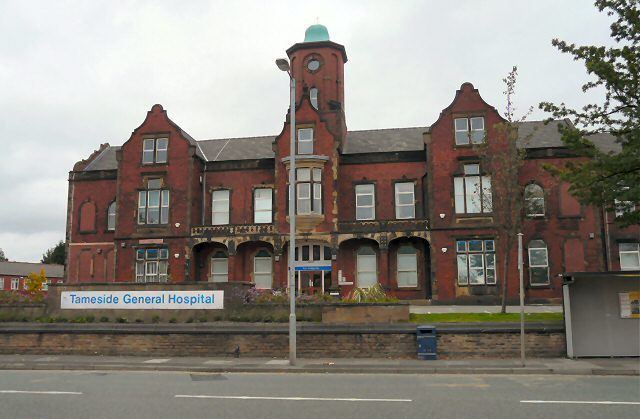Care system Public NHS Lists Hospitals in England Founded 1861 | Hospital type District General Phone +44 161 331 6000 | |
 | ||
Emergency department Yes Accident & Emergency Website www.tamesidehospital.nhs.uk Similar Stepping Hill Hospital, Fairfield General Hospital, Pennine Acute Hospitals, Christie NHS Foundati, Royal Manchester Children | ||
Tameside General Hospital is a National Health Service (NHS) hospital situated in Ashton-under-Lyne. Run by Tameside Hospital NHS Foundation Trust, it serves the surrounding area of Tameside in Greater Manchester, and the town of Glossop in Derbyshire. Employing just under 2,500 staff, the hospital provides a wide array of healthcare one would associate with general hospitals, including Accident and Emergency services, and full consultant-led obstetric and paediatric hospital services for women, children and babies.
Contents
History
Tameside Hospital has been around in one form or another since its foundation in 1861 by founders Samuel Oldham and Henry Darnton. Oldham's stated intention in founding Ashton District Infirmary was to create an institution "for the relief and cure of sick and indigent persons resident, employed, or having been employed within 3½ miles of Ashton Town Hall." After its formation a separate workhouse was built nearby.
Upon the formation of the NHS in 1948, the old hospital joined with the buildings of the old workhouse to form the new Ashton-under-Lyne General Hospital, now dedicated to fulfilling the NHS's ideals of providing healthcare to all, regardless of ability to pay. The hospital changed its name to Tameside General Hospital in 1976, following the establishment of Tameside Metropolitan Borough Council in 1974 and over the following decades new buildings were built to provide better standards of care for local people.
Paul Connellan was appointed Chair of the Trust in November 2011
The trust was loaned more than £14m by the Department of Health in 2014, and needs a £25m loan in 2015 to keep paying staff and suppliers. It expects a deficit of £25.8 million for 2015/6.
Performance
In 2005 the hospital received the maximum three star rating from the Healthcare Commission in recognition of the quality of its services, and was granted Foundation Trust status on 1 February 2008. However, in 2009 it was identified as having the third highest mortality rate in England. In July 2013 The Guardian newspaper disclosed the existence of two previously unpublished critical reviews commissioned by the hospital which revealed concerns about chronic under-staffing and sub-standard care. Christine Green, the chief executive, and Dr Tariq Mahmood, the hospital's medical director, both resigned as a result of the disclosure.
The Trust is one of a small number implementing the Lorenzo patient record systems having accepted a controversial financial support package.
In July 2013 as a result of the Keogh Review the Trust was put into special measures by Monitor In October 2013 the Trust was put into the highest risk category by the Care Quality Commission. It was taken out of special measures in September 2015.
In November 2013 the Trust released the first six months results from the Friends and Family Test which appeared to show improvements in patient satisfaction on the wards, but a decline in the casualty department. The scores range from -100 (lowest) to +100 (highest).
It spent 11.9% of its total turnover on agency staff in 2014/5 - the second biggest proportion of any NHS Trust in England.
In the last quarter of 2015 it had one of the worst performances of any hospital in England against the four hour waiting target.
Future plans
The trust plans to become an integrated care organisation, employing social care staff with a capitated payment system. GPs may join the trust as salaried staff. Subspecialty services in medicine and surgery and outpatient clinics would be provided by other trusts.
Jeremy Hunt (politician) visited the hospital in June 2015 saying “I think the management of the trust has completely changed. The staff have managers who listen to them if they have concerns and I think everyone here deserves huge congratulations for the progress they have been making in turning the hospital around.”
Local Population
Located near the Pennines, eight miles east of Manchester, the hospital serves a population of over 250,000. The population is concentrated in the largely urban areas of the townships of Tameside (Ashton-under-Lyne, Audenshaw, Denton, Droylsden, Dukinfield, Hyde, Longdendale, Mossley and Stalybridge) which comprises Tameside Metropolitan Borough Council. Glossop, with its population of approximately 32,000 is part of Derbyshire High Peak Borough Council, which provides the challenges of a more rural community.
Maternity
Two World Cup-winning footballers were born in the hospital: Geoff Hurst, to whom there is a plaque within the maternity unit, and Simone Perrotta.
Future developments
It is proposed to redesign health services in the area by bringing hospital and community care together in a programme called Care Together. It is proposed that most care will be provided outside hospital, at home or close to where people live. The trust plans to become an integrated care organisation, employing social care staff with a capitated payment system. GPs may join the trust as salaried staff. Subspecialty services in medicine and surgery and outpatient clinics would be provided by other trusts.
The new organisation brings together Tameside and Glossop Clinical Commissioning Group, Tameside Metropolitan Borough Council,part of Derbyshire County Council, and the Foundation Trust with the borough council Chief Executive leading the organisation.
